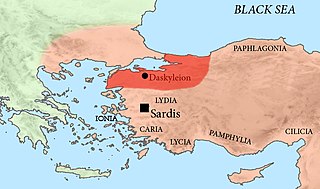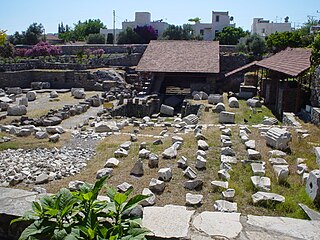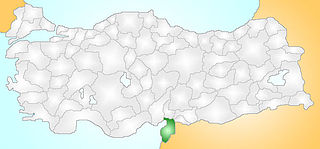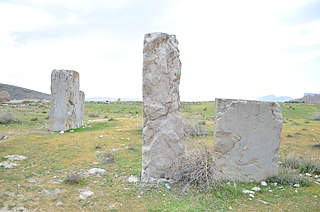 W
WCyropolis was an ancient city founded by Cyrus the Great in 544 BCE to mark the northeastern border of his Achaemenid empire.
 W
WDahan-e Gholaman or Dahaneh-e Gholaman is the modern name of a major Achaemenid center and archeological site in eastern Iran. It has been identified as Zranka/Zarin, the capital of the satrapy of Zranka/Drangiana.
 W
WDarab — formerly Darábghird, or Darábgerd — is a city and capital of Darab County, Fars Province, Iran. At the 2006 census, its population was 54,513, in 13,279 families.
 W
WDascylium, Dascyleium, or Daskyleion, also known as Dascylus, was a town in Anatolia some 30 kilometres (19 mi) inland from the coast of the Propontis, at modern Ergili, Turkey. Its site was rediscovered in 1952 and has since been excavated.
 W
WDoriscus was a settlement in ancient Thrace, on the northern shores of Aegean Sea, in a plain west of the river Hebrus. It was notable for remaining in Persian hands for many years after the Second Persian invasion of Greece, and remained thus known as the last Persian stronghold in Europe.
 W
WEion, ancient Chrysopolis, was an ancient Greek Eretrian colony in Thracian Macedonia specifically in the region of Edonis. It sat at the mouth of the Strymon River which flows into the Aegean from the interior of Thrace. It is referred to in Thucydides' History of the Peloponnesian War as a place of considerable strategic importance to the Athenians during the Peloponnesian War.
 W
WGanzak, is an ancient town founded in northwestern Iran. The city stood somewhere south of Lake Urmia, and it has been postulated that the Persian nobleman Atropates chose the city as his capital. The exact location, according to Minorsky, Schippmann, and Boyce, is identified as being near Leylan, Malekan County in the Miandoab plain.
 W
WGonabad is a city and capital of Gonabad County, in Razavi Khorasan Province, Iran. At the 2011 census, its population was 36,367, in 10,389 families. Jūymand is an affluent northern district/suburb of Gonabad.
 W
WHalicarnassus was an ancient Greek city at what is now Bodrum in Turkey. It was located in southwest Caria on a picturesque, advantageous site on the Ceramic Gulf. The city was famous for the Mausoleum of Halicarnassus, also known simply as the Tomb of Mausolus, whose name provided the origin of the word "mausoleum". The mausoleum, built from 353 to 350 BC, ranked as one of the seven wonders of the ancient world.
 W
WIssus or Issos is an ancient settlement on the strategic coastal plain straddling the small Pinarus river below the navigationally difficult inland mountains towering above to the east in the Turkish Province of Hatay, near the border with Syria. It can be identified with Kinet Höyük in the village of Yeṣilköy near Dörtyol in the Hatay province of Turkey. Excavations on the mound occurred between 1992 and 2012 by Bilkent University. It is most notable for being the place of no fewer than three decisive ancient or medieval battles each called in their own era the Battle of Issus:The Battle of Issus ; Alexander the Great of Macedonia defeated Darius III of Persia. This battle is occasionally called the First Battle of Issus, but is more generally known simply as the Battle of Issus, owing to the importance of Alexander's victory over the First Persian Empire and its impact on subsequent history of the region, including all the successor polities. Battle of Issus (194), or Second Battle of Issus — between the forces of Emperor Septimius Severus and his rival, Pescennius Niger. Battle of Issus (622), or Third Battle of Issus — between the Byzantine Empire and the Sassanid Persian Empire.
 W
WIstakhr was an ancient city in Fars province, five kilometres north of Persepolis in southwestern Iran. It flourished as the capital of the Persian Frataraka governors and Kings of Persis from the third century BC to the early 3rd century AD. It reached its apex under the Sasanian Empire, and was the hometown of the Sasanian dynasty. Istakhr briefly served as the first capital of the Sasanian Empire from 224 to 226 AD and then as principal city, region, and religious centre of the Sasanian province of Pars. During the Arab conquest of Iran, Istakhr was noted for its stiff resistance, which resulted in the death of many of its inhabitants. Istakhr remained a stronghold of Zoroastrianism long after the conquests, and remained relatively important in the early Islamic era. It went into gradual decline after the founding of nearby Shiraz, before being destroyed and abandoned under the Buyids. Cursorily explored by Ernst Herzfeld and a team from the University of Chicago in the first half of the 20th century, much of Sasanian Istakhr remains unexcavated.
 W
WKashmar is a city and the capital of Kashmar County, in Razavi Khorasan Province, Iran. Cahitu is located near the river Sish Taraz in the western part of the province, and 217 kilometres (135 mi) south of the province's capital Mashhad, in Iran, from east to Bardaskan, west to Torbat-e Heydarieh, north to Nishapur, south to Gonabad. Until two centuries ago, this city was named Torshiz (ترشیز). At the 2006 census, its population was 81,527, in 21,947 families.
 W
WNeyriz is the capital city of Neyriz County, Fars Province, Iran. At the 2016 census, its population was 113,291, in 31,819 families.
 W
WThe Palace of Darius in Susa was a palace complex in Susa, Iran, a capital of the Achaemenid Empire. The construction was conducted parallel to that of Persepolis. Man-power and raw materials from various parts of the empire contributed to its construction. It was once destroyed by fire and was partially restored later. Little has remained from this important complex.
 W
WPanjakent, or Penjikent, is a city in the Sughd province of Tajikistan on the river Zeravshan, with a population of 52,500. It was once an ancient town in Sogdiana. The ruins of the old town are on the outskirts of the modern city. The Sarazm Important Bird Area lies downstream of the city on the tugay-vegetated floodplain of the river.
 W
WPasargadae was the capital of the Achaemenid Empire under Cyrus the Great, who ordered its construction. Today it is an archaeological site and one of Iran's UNESCO World Heritage Sites, about 90 kilometres (56 mi) to the northeast of the modern city of Shiraz. A limestone tomb there is believed to be that of Cyrus the Great.
 W
WPersepolis was the ceremonial capital of the Achaemenid Empire. It is situated 60 kilometres (37 mi) northeast of the city of Shiraz in Fars Province, Iran. The earliest remains of Persepolis date back to 515 BC. It exemplifies the Achaemenid style of architecture. UNESCO declared the ruins of Persepolis a World Heritage Site in 1979.
 W
WSardis or Sardes was an ancient city at the location of modern Sart, near Salihli, in Turkey's Manisa Province. Sardis was the capital of the ancient kingdom of Lydia, one of the important cities of the Persian Empire, the seat of a Seleucid Satrap, the seat of a proconsul under the Roman Empire, and the metropolis of the province Lydia in later Roman and Byzantine times. As one of the seven churches of Asia, it was addressed by John, the author of the Book of Revelation in the New Testament, in terms which seem to imply that its church members did not finish what they started, that they were about image and not substance. Its importance was due first to its military strength, secondly to its situation on an important highway leading from the interior to the Aegean coast, and thirdly to its commanding the wide and fertile plain of the Hermus.
 W
WSusa was an ancient city in the lower Zagros Mountains about 250 km (160 mi) east of the Tigris River, between the Karkheh and Dez Rivers. One of the most important cities of the Ancient Near East, Susa served as the capital of Elam and the Achaemenid Empire, and remained a strategic centre during the Parthian and Sasanian periods.
 W
WUlug Depe is an ancient Bronze Age site in the foothills of the Kopet Dag Mountains in the Karakum Desert of Kaka District (Kaahka) in the Ahal Province of south-eastern Turkmenistan. It covers around 13 hectares and lies on a mound at a height of about 30 meters, displaying the longest stratigraphic sequence of Central Asia, from the Late Neolithic, represented by Jeitun culture, until the pre-Achaemenid period.